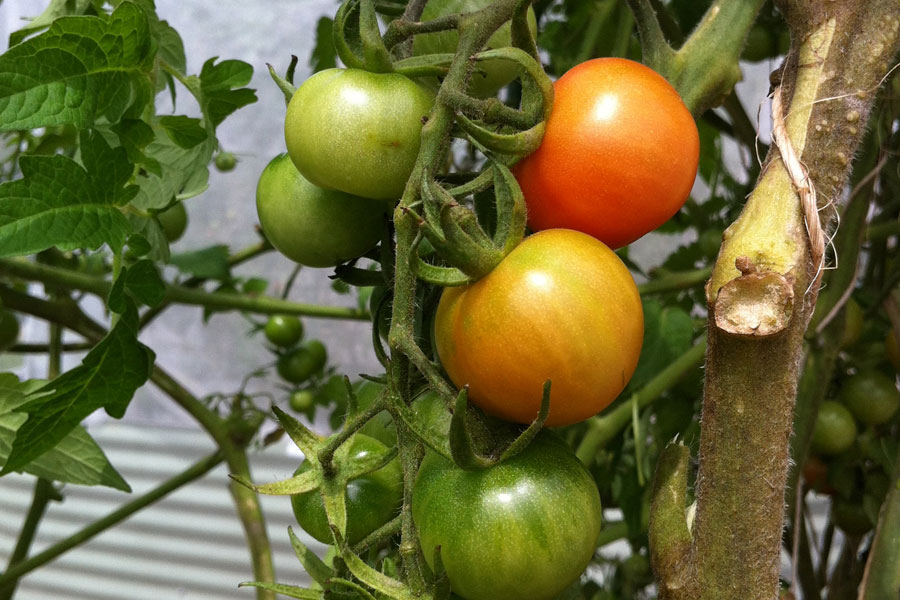
Botanical name:
Solanum lycopersicum
Description:
Tomatoes are part of the nightshade or solanaceaes family. Only the fruit of tomatoes are edible! Flowers, greens and shoots should not be consumed because they contain a toxin.
There are varieties that grow like a bush and varieties that grow like vines. Tomato plants are vigorous growers. They produce a side shoot in nearly every angle between a leaf and a stem. To contain and guide the growth of the vine these shoots must be pruned heavily.
The flower of the tomatoes is a very tiny, yellow version of the typical 5 pointed nightshade flower. The tomato fruits start green and even though the majority of cultivars show variations of red, they can show all sorts of colours from green to yellow and orange, from red to nearly black. Some varieties are small like a cherry, some big as a fist. The taste of the juicy fruit is sweet and sour.
In our beds you will most likely find small varieties like Tommy Toe and Yellow Fig tomatoes and medium varieties like Amish Paste and Black Russian.
How to grow:
Tomatoes are a warm season crop, that will only grow in the warm months with plenty of sun.
Sow in seed beds end of July, three times as deep as the seed into a light, well drained soil. Keep moist and warm. After the plants are about 5 to 8 cm high and show at least 4 to 6 leaves, transplant into single pots. Fertilise once per week with liquid fertiliser.
Plant out in the garden beds in October into soil enriched with compost. Place 40 cm apart, rows 50 cm apart.
Support the plants by tying them to stakes until they are about 70 cm high. Since we opt to grow tomato vines, we hang them on strings hanging from a support structure or tie them on very long stakes.
Remove the majority of the side shoots which grow in the angle between the leaf stems and the main stem of the plant.
Feed every week with liquid fertiliser.
4 to 5 weeks from transplanting into the beds to harvest.
Growing in the neighbourhood:
Likes to grow with basil, parsley, marigold. Doesn’t like fennel and rosemary.
Pests and other problems and how we deal with them:
In our area tomatoes are strongly affected by tomato bud worms. This is the caterpillar of a moth that lives in the fruit and spoils it. We build big tents with fine meshed netting around our tomato beds, so the moth can’t reach the plants and lay eggs. If we still find affected fruit we spray with a bacterial spray that reduces the caterpillars naturally.
Yellow leaves on tomatoes indicate a lack of magnesium
Season:
Late Spring to late Summer
Seed-saving:
The plants are wind pollinated. Seed saving of true seeds should be possible if only plants of one cultivar are kept under one tent. Squeeze seeds out of the tomato into a glass of water and wait for them to rot for about a week. Wash the seeds, that are now free of any mucous, and dry them.
How to harvest and use:
Pick regularly as soon as the fruits are ripe. This encourages the production of more tomatoes.
Tomatoes are great on their own, just with some pepper and salt, or with fresh herbs like basil and thyme. Dried tomatoes kept under oil keep fresh for more than a year in the fridge. Saffron gives tomatoes a Spanish twist.